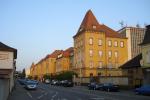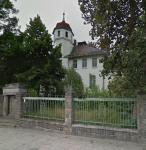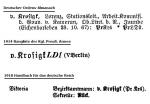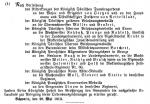-
Posts
4,908 -
Joined
-
Last visited
-
Days Won
97
Content Type
Profiles
Forums
Blogs
Gallery
Events
Store
Everything posted by Dave Danner
-
The Saxon KVK was awarded mainly for homefront merit to persons who did not receive another Saxon war decoration. Each state had its own rules for what qualified one for so-called "combatant" versus "non-combatant" awards. For Prussia, the Iron Cross was awarded on the black/white ribbon to serving military personnel, even those on the homefront. So a soldier serving, for example, in the the Kriegsamt in Berlin or in a POW camp would receive the Iron Cross on the black/white ribbon. In any event, as Ehrenkreuz für Frontkämpfer shows, this guy did see some time at the front. But of course, he didn't have to stay there. He could have been wounded and spent the rest of the war in the rear. Or he could have been a Zeugfeldwebel or Feuerwerker, spending some time at the front with an artillery regiment and then back to an artillery depot or Zeugamt for the rest of the war.
-
FAR 18's Kaserne is still there, although partly collapsed. It was a Soviet barracks, I believe. The nearby GR 12 barracks is now a university. FAR 25's Kaserne was destroyed during World War II, as was almost the entire complex of the Großherzoglich Hessische Division on the southwest side of Darmstadt. Parts, including I believe some of Train-Abteilung Nr. 18's barracks, were used by the US Army. The Kasernes of DR 23 and DR 24 are almost entirely gone, as is most of that of LGIR 115. For FAR 28, the wings of the Kaserne buildings are there, but the center parts of both barracks are gone, turning two long buildings into four shorter ones. Elsewhere in Bautzen, IR 103's complex is mostly gone, while HR 20's is mostly still there. Here is a Google Earth street-level view of the Offizier-Kasino in Nysa:
-
To the first question: the award document or the reference (rank list, DOA, Ordensliste) will say so: "am schwarzen Bande mit weißer Einfassung" or "am weißen Bande mit schwarzer Einfassung" or something similar. To the second question: as Matt says, most awards on the black/white ribbon were also with swords. In addition, most awards on the white/black ribbon to medical personnel were with swords. Awards on the white/black ribbon without swords were for homefront merit. There were, however, a small number of exceptions. A handful of awards were made on the black/white ribbon without swords. There was at least one award with swords on the statute ribbon (to an Ottoman officer). There were also a few awards on the ribbon of the Rettungsmedaille. All this applies to the 4th Class. The 3rd Class had even more complicated variations, since it depended not just on what the award was for, but on whether one already had the 4th Class and in which version.
-
Not a mistake. He was transferred from KR 7 to KR 8 on 20 July 1898. The Ehrenrangliste seems to have a huge number of officers listed by the regiment they briefly served in just before retiring rather than the one they spent the majority of their career in. The 1916 MWB says when he was given the Charakter as an Oberstleutnant, he was commander of the Sammelstelle I (Garde) in Berlin. His Jubilee Medal is in the Anhalt list, though without a first name - just major in KR 7. Despite the two previous Anhalt awards, he did not get a Friedrichkreuz, on either the green-red or the green-white ribbon, during the war.
-
I would say possibly a Zeugoffizier. Up through the ranks as a Zeugfeldwebel, Zeugleutnant at various artillery depots, out as an Oberleutnant or Hauptmann beim Zeugamt, recalled as a Waffenoffizier. The Red Eagle ribbon may be the Roter-Adler-Medaille, not the order. There is a small chance that such a combination is somewhere in all my Wehrmacht personnel file notes. Rick would really have loved these.
-
His full name was the opposite of brief: Hyazinth Maximilian Telesphor Maria Josef Lieber. He was the son of Ernst Lieber (1838-1902), a politician and member of the Reichstag, and Josefine Arnold (1853–1932). He was also the nephew of Dr. med. August Lieber, a doctor and poet in Innsbruck, who had moved to Austria from Nassau during his medical studies. According to the Jahresverzeichnis der deutschen Hochschulschriften, although a Prussian citizen and Bavarian reservist, Hyazinth received his Dr. jur. in Saxony, from the University of Leipzig on 4 August 1909. His legal studies had taken him to Munich and Würzburg, among other schools, which is presumably why he did his military service in Bavaria. He entered service on 1 April 1902 (I presume as a one-year volunteer) and was commissioned a Lt.d.R. on 11 February 1908. The first wound in August 1914 was a bullet to the gut (Bauchschuß G.G.) in fighting by Bertrimoutier, near St. Dié. The second, fatal, wound, was a bullet to the lower jaw (Unterkiefer G.G.) by Senones. He was at the time Kompanie-Führer of the 4.Komp., bayer. Brigade-Ersatz-Bataillon Nr. 8, bayer. Ersatz-Infanterie-Regiment Nr. 2.
-
This seems to often be a problem for reserve and Landwehr officers. Here, for example, are three separate entries for Lorenz von Krosigk from various sources. He was a Hptm.d.R. in HR 10. He earned his LD1 sometime after the DOA came out, which the rank list reflects, but his Crown Order doesn't show up. His entry in the Reich handbook shows the Crown Order, but omits the LD1.
-
The Nimmergut catalog is a good pocket reference (12.5 x 19 cm or 5 x 7.5 inches) to have when you go to shows or see an auction, since it gives a rough (really rough) idea of market values. It is also nice to see that it is now in color. I have not gotten a new one in so long that mine still has DM next to Euros. But it tells you nothing about the awards themselves. What they were awarded for, whom they were awarded to (important in a class-based society), what the differences among the various devices, attachments, etc. mean, how many were awarded, etc. So while helpful in identifying what something is, it doesn't really help in determining whether it is what you want.
-
Schmoller was awarded the BMV4 on 18 June 1909, although it was not published by the Bavarian Kriegsministerium until 25 September 1909. Schmoller's award was at the same time as then-Lt. Frisch in the same regiment, shown immediately after Schmoller in the MWB excerpt which Glenn attached. Frisch, who remained in DR 7 and was promoted to OLt. on 27.1.10, is correctly shown in the 1910 rank list with the BMV4. Schmoller was transferred to JRzP 5 and the error already shows up there, where the 1910 rank list has him with KO4 and BM4a. At the same time that Schmoller and Frisch were awarded the BMV4, Major Freiherr von Broich of DR 7 was awarded the BM3. That is also correctly shown in the rank list. Freiherr v. Broich already had the BMV3, so I suppose he was awarded the St. Michael since he wasn't senior enough to get a crown to the BMV3. Did the publishers of the rank list rely on the units themselves to provide updated information? I suppose when Rittm. Schmoller arrived at JRzP 5, someone misread his file and wrote BM instead of BMV.
-
It appears to be some sort of commemorative medal for Sheikh Zayid bin Sultan An-Nahyan, the founder of the United Arab Emirates. On the blank side, it says on the top "In memory of" or "Commemorative of", and on the bottom "United Arab Emirates". On the side with the bust, it says Sheikh Zayid bin Sultan An-Nahyan on the top (there is a word before Sheikh I can't make out, though) and on the bottom again "United Arab Emirates" (there is another partially worn-out word before Dawlah I can't make out). http://en.wikipedia.org/wiki/Zayed_bin_Sultan_Al_Nahyan
-
It's not a medal. It is a token made as a copy of an Ottoman 500 kurush gold coin. Copies of coins like this were seen throughout the Middle East as jewelry, on things like wedding dresses and veils, perhaps as good luck charms.
-
For a pure Prussian in a purely Prussian regiment whose honorary chief was not also a sovereign, I'd agree with Rick that an EK2, and maybe a peacetime long service medal, were almost all they could expect. For that matter, I think most Prussian officers could expect little more than an EK2, and an EK1 if they were lucky, if they weren't in the right regiments. Here is a list of awards of the General Honor Decoration, Red Eagle Order Medal and Crown Order Medal to NCOs in Feldartillerie-Regiment Nr. 60. This was a Mecklenburg regiment, though part of the Prussian Army. I have no idea why they received these medals, or the Danish awards to the Landesgendarmerie for that matter. I have also seen a handful of such medals gazetted to Württemberg NCOs. Perhaps for non-Prussians in the German Army, Prussia sometimes used these medals the way a state like Mecklenburg or Württemberg would use the medals of their own orders. Other than these and a few odd cases, almost the only awards I've seen of the Red Eagle and Crown Order Medals to Prussian NCOs were to technical NCOs like Zeugfeldwebels. One of the odd ones: Bruno Doehler, a 19-year old native Silesian and Fähnrich in the Ersatz-Bataillon of Infanterie-Regiment Nr. 148, received the Medal of the Red Eagle Order on 4 August 1917, when he was just two months out of the Hauptkadettenanstalt, and three months before his baptism of fire. I have no idea why.







